SUPPORTING CITY KNOW-HOW
Human health and planetary health are influenced by city lifestyles, city leadership, and city development. For both, worrying trends are leading to increasing concern and it is imperative that human health and environmental impacts become core foci in urban policy. Changing trajectory will require concerted action; the journal Cities & Health is dedicated to supporting the flow of knowledge, in all directions, to help make this happen. We wish to foster communication between researchers, practitioners, policy-makers, communities, and decision-makers in cities. This is the purpose of the City Know-how section of the journal. We invite you to join these conversations. In order to strengthen the community of interest, we would like to include many and varied voices, including those from younger practitioners and people who are supporting health and health equity in everyday urban lives
This issue of Cities & Health comprises 20 articles shedding light on many aspects of spatial planning, design and governance for urban health.
Our seven shorter pieces include a visual essay from Kuwait, three book reviews and a review of last year’s Healthy City Design congress. “Research for city practice” has summaries of 13 research articles. This is where you can scan for shared urban problems and find some solutions. The studies and findings are distilled here to support for city and town-based action for health.
Also in this issue, we highlight another “Reflective Praxis – Think-piece”. In these articles researchers and practitioners share “on the job” learning for others to gain insight into their experiences.
We seek to encourage learning by sharing. We encourage those in towns and cities to share their own stories through publishing what we call a “City Shorts”. We welcome conjecture, commentary and debate arising from practitioners and researchers who are trying to make human settlements healthier, and more equitable for communities, and healthier for the planet.
Exploring the design, quality and use of communal areas in apartment developments
Communal rooftop terrace with barbecue facilities. Photo by Alexandra Kleeman.

Higher quality communal areas (including amenities/features such as greenery, pools, barbecues, seating and a ground floor location) were associated with greater use of communal areas in apartment developments.
For the attention of: Policy-makers, developers, academics and architects
The problem: In the context of global urbanisation, creating high-density living environments that promote health, wellbeing and social connectedness is vital. In apartment buildings, residents live in close physical proximity and share communal areas, however not all areas are equal in design and quality, which may impact usage and opportunities for social interaction.
What we did and why: Using a novel desktop audit approach, we objectively identified communal area design features and examined their association with residents’ use of communal areas in apartment developments across Perth, Melbourne and Sydney.
What our study adds: This appears to be the first attempt to utilise an objective audit tool that assesses a number of design themes across communal areas. Our study results suggest that the delivery of high-quality communal areas can encourage use, which in turn, may have implications for residents’ social opportunities and outcomes.
Implications for city policy and practice: The findings have policy and design implications, suggesting that the provision of communal space alone may not be enough to encourage use without the design features or amenities that appeal to residents.
Full research article: Exploring the design, quality and use of communal areas in apartment developments by Alexandra Kleeman, Billie Giles-Corti, Lucy Gunn, Paula Hooper & Sarah Foster.
Communal area design in apartment buildings: Development and comparison of a desktop and on-the-ground landscape assessment tool
Communal terrace amenities, including greenery, seating and [lack of] shelter. Photo by Alexandra Kleeman.
![Communal terrace amenities, including greenery, seating and [lack of] shelter. Photo by Alexandra Kleeman.](/cms/asset/c9c0efdd-c1e0-4a96-bc34-b16095426471/rcah_a_2111122_uf0002_c.jpg)
New analysis methods were assessed. The majority of audit tool items showed moderate/almost perfect reliability. The desktop method was a valid alternative to on-site auditing, truncated but more time-efficient and economical.
For the attention of: Policy-makers and developers interested in designing high performance communal spaces in apartment buildings.
The problem: In the context of global urbanisation, creating high-density living environments that promote health, wellbeing and social connectedness is vital. In apartment buildings, residents live in close physical proximity and share communal areas, however not all areas are equal in design and quality, which may impact usage and opportunities for social interaction.
What we did and why: We developed and compared an on-the-ground and desktop approach to auditing communal area design and quality. The Communal Areas Audit Tool (CAAT) and Communal Areas Desktop Audit Tool (CADAT), which measured design features that can impact residents use of (and interaction within) communal areas, were assessed for reliability and validity.
What our study adds: Our work appears to be the first attempt to develop objective audit tool(s) that systematically and consistently assess a number of design themes across communal areas.
Implications for city policy and practice: The application of the Communal Areas Desktop Audit Tool would be highly relevant for large-scale data collection in studies examining the intersection between high-density apartment living, the provision and quality of communal areas and residents’ social outcomes. Note that this may become increasingly important in rapidly densifying cities.
Full research article: Communal area design in apartment buildings: development and comparison of a desktop and on-the-ground landscape assessment tool by Alexandra Kleeman, Lucy Gunn, Billie Giles-Corti & Sarah Foster.
Are houses in disadvantaged and less walkable areas affordable?
Photo of Brunswick Street and surrounding residential areas in Melbourne, Australia showing walkable access to shops and services. Photo credit: Roberto Seba. Shopping on Brunswick Street, with permission from Visit Victoria.

Housing in disadvantaged areas is more affordable, however, cities would be more equitable if disadvantaged areas were walkable and amenity rich, with existing liveable neighbourhoods having more social housing.
For the attention of: Urban planners and city governments.
The problem: Access to affordable housing supports peoples’ health and wellbeing, yet, not all houses are affordable nor are they located in amenity rich liveable neighbourhoods.
Typically, more established neighbourhoods are amenity-rich and more liveable whilst amenity-poor neighbourhoods are more affordable but located in outer-suburban locations, placing people far from the places and destinations they need.
By incorporating disadvantage, our research explored an overlooked aspect of the relationship between housing affordability, walkability and the built environment.
What we did and why: We studied whether relationships between walkability and house prices (i.e. price premiums or discounts) differed by neighbourhood-level disadvantage. We did this by using hedonic pricing models stratified by five levels of disadvantage using data from metropolitan Melbourne, Australia and explanatory built environment variables including walkability and its components (street connectivity, dwelling density and destination access), and public transit access. Hedonic pricing models are useful for measuring the value of environmental features when no other estimates exist.
What our study adds: We found that:
destination access increased house prices;
distance from transit reduced house prices;
disadvantaged neighbourhoods had lower levels of walkability compared to more advantaged neighbourhoods;
the association between walkability and house prices was weakest in the most disadvantaged neighbourhoods.
Our findings suggest that houses in disadvantaged neighbourhoods were more affordable because they lacked amenity in terms of walkability, destination access and transit.
Implications for city policy and practice: Future planning could redress inequities in walkability and housing affordability by retrofitting existing neighbourhoods and making new neighbourhoods more walkable from the outset. Increasing densities in outer suburban areas could make destination and transit provision and access more viable. However, in established amenity rich neighbourhoods with good access to destinations and transit, inclusionary zoning policies could reduce inequities by ensuring disadvantaged neighbourhoods have social and affordable housing.
Full research article: Exploring inequities in housing affordability through an analysis of walkability and house prices by neighbourhood socioeconomic disadvantage by Lucy D. Gunn, Tayebeh Saghapour, Billie Giles-Corti & Gavin Turrell.
Making cities inclusive for children with disabilities: the development of the Child Community Health Inclusion Index
The CHILD-CHII framework. Photo by Keiko Shikako.
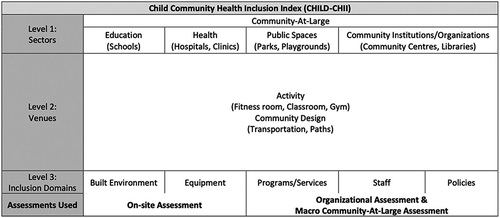
We must take a careful look into the structures, policies, and programs that may be barriers to inclusion of children with disabilities in the community. Assess to intervene and create cities that are inclusive of and healthy for all!
For the attention of: Policymakers, municipal program managers, public health practitioners, community organizations, and disability advocacy organizations.
The problem: Children with disabilities are often marginalized when they face restrictions in engaging in community life, placing them at risk for unfavourable outcomes in relation to their health and wellbeing. Public health initiatives and public health and social policy must address the needs of this population.
What we did and why: We did a comprehensive review of existing measures and tools that assess the inclusion of children in the community. We obtained expert input to develop the content of the Child Community Health Inclusion Index (CHILD-CHII). The tool addresses the diverse needs of children with various dis- abilities with a generalizable, universal design approach for community inclusion. The content was then validated through a consensus process with experts, and the items of the tool were further clarified in this study.
What our study adds: This tool evaluates how facilities, public spaces, and municipal policies address the inclusion of children with disabilities in the Canadian context. The validated content highlights the importance of such tool to identify barriers to inclusion, and to inform the development of interventions and initiatives to address these barriers.
Implications for city policy and practice: The Child Community Health Inclusion Index can contribute to cities to assess all health, community, leisure, and educational facilities and programs, and address improvements necessary to align with higher level frameworks such as the UN sustainable development goals and the Convention on the Rights of Children and on the Rights of Persons with Disabilities. The use of this tool can support the development of inclusion strategies that can contribute to child and disability -friendly cities.
For further information:
Childhood Disability Link: Linking Information and New Knowledge on childhood disability to service providers and families.
Jooay: Jooay is a free app that helps children with disabilities and their families to locate leisure opportunities.
Full research article: Content validation of the child community health inclusion index: a modified e-Delphi study by Paul Yejong Yoo (@_paulyoo), Annette Majnemer, Robert Wilton, Sara Ahmed & Keiko Shikako (@KeikoShikako).
Can crowdsourced data help us understand access to health-promoting programs in cities? A case study on Canadian cities
The jooay app. Photo by Ebele R.I. Mogo.

Big data is valuable for understanding the spread of health-enabling resources in cities. But what happens when those resources are not visible via GIS? We explored crowdsourced data as a solution.
For the attention of: Urban health implementers, Impact investors, City governments, Technologists, Digital health innovators and Childhood disability advocates.
The problem: Monitoring neighbourhood-level access to resources, services and programmes, can help to improve health equity in communities. With the proliferation of digital applications, big data approaches have shown some promise in capturing access to such resources such as green spaces, housing, amongst others. However, it is often difficult to capture resources such as programmes that are not spatially observable and as such, “offline” and pre-populated records are often used to gather such data.
What we did and why: We explored linking “online” data from a digital listing of inclusive physical and leisure activity programs to data on neighbourhood-level deprivation, firstly to explore insights on the relationship between both factors, and secondly, to explore how to strengthen novel approaches for capturing equity in access to health-promoting programs.
What our study adds: Past evidence gathering and stakeholder engagement efforts have noted the need for a wider range of activities, staff training and resources to accommodate varying sensory and behavioural challenges of Canadian children with disabilities. However to our knowledge, this is the first effort to systematically collect data on actual adapted and inclusive programmes offered on a large scale and covering a broad geographical area, informed by a purposeful and crowd-sourced database as opposed to individual reports.
Implications for city policy and practice: City-level policy makers and practitioners should note varying dimensions of access, of target populations, and of deprivation in using crowdsourced data to evaluate access to health promoting resources. Additionally, crowdsourced data collection should consider how characteristics of the design team, and analytical and interpretive assumptions may influence results.
For further information: Jooayapp: Connecting children and youth with disabilities to leisure. A free app that helps children with disabilities and their families to locate leisure opportunities that are: close to where they are, accessible, suit their needs and abilities, match their preferences, can help them develop and participate in society (@jooay).
Full research article: Using crowdsourced data to assess the relationship between neighbourhood-level deprivation and the availability of inclusive leisure programmes in Canadian cities by Ebele R.I. Mogo (@ebyral), Luca Martial, José A. Correa, Annette Majnemer & Keiko Shikako (@KShikakothomas).
How do we make sustainable and healthy diets acceptable, appealing, and appropriate in local settings?
Danish fish market. Photo by Nick Karvounis on Unsplash.

How can healthy, sustainable diets be accessible and appealing? We explore how Copenhagen residents navigate their food environments, what shapes their food practices, and what they’d like to change.
For the attention of: Those in charge of Copenhagen’s food strategy and food strategies in other cities worldwide. International and national food NGOs.
The problem: Poor diets are both the leading cause of morbidity and mortality globally, while also being a key driver of climate change. While efforts have been made to design a global diet that is good for both people and planet (the Eat-Lancet reference diet), this diet does not take into account different eating norms in different places nor how they might affect uptake.
What we did and why: To understand how people in one Copenhagen neighbourhood navigated their food environments and explore the implications for bringing diets in line with the Eat-Lancet reference diet, we designed a photo-elicitation study. Over three weeks, participants took photos of their food environments and the facilitators and barriers to healthy eating. They attended workshops where they discussed these photos and reflected on how a healthy and sustainable diet might be facilitated.
Our study adds:
Insights into the different factors that shape people’s food purchasing and consumption and how they interact with each other.
Insights into how the food environment might need to be adapted so that foods that fit in with a healthy and sustainable diet are affordable, appealing, and accessible.
Insights that are grounded in the lived experiences and critical reflections of people living and eating in one neighbourhood of Copenhagen.
Implications for city policy and practice: Adapting the Eat-Lancet reference diet to local circumstances requires a deep understanding of how and where people acquire food, and what other roles food plays in people’s lives. To reshape diets, what is available in the food environment must match what fits in with pre-existing practices and values.
Policy makers must understand the non-monetary benefits that food environments bring to people, such as providing time for other activities or promoting broader wellbeing through social engagement.
For further information:
EAT-Lancet: The EAT-Lancet Commission on Food, Planet, Health
Full research article: Gathering data on food environments and food practices through photo elicitation in Copenhagen, Denmark: Implications for adapting the EAT-LANCET reference diet to local circumstances by Anna Isaacs, Mark Spires, Afton Halloran & Thomas Stridsland.
Status of solid waste management policy implementation in Kenya
Nairobi City official dumpsite at Dandora. Photo by Dickson A. Amugsi.

Solid waste production is rapidly increasing in Kenyan cities. However, the implementation of available policies to address the canker leaves much to be desired.
For the attention of: UN-Habitat and the UN environmental programme (UNEP).
The problem: Solid waste management is a significant issue confronting many countries across the world. It is particularly severe in low and middle countries, where solid waste production is on the ascendency. In Kenya, estimates indicate that Nairobi residents produce between 3,000 and 3,200 tons of solid waste each day. Other cities in the country face similar challenges. In light of this, the government has formulated several policies and regulations to address the menace. However, there are deficiencies in the implementation of these policies. This situation is unlikely to be confined to Kenya.
What we did and why: We used focus group discussions, key informant interviews and in-depth interviews in the data collection. We used these approaches because they offer the opportunity to investigate the issues in a more in-depth yet broader manner. We interviewed SW pickers/workers, community members/leaders, community-based organisations, waste collection companies, non-governmental organisations, government representatives, staff of county governments, national government agencies, and bilateral partners. All interviews were audio-recorded and transcribed verbatim by professional transcribers.
What our study adds: Our approach used helped to identify solid waste management policy implementation gaps and opportunities that could be utilised:
We assessed policy implementation and at the same time identified existing opportunities. A first study to the best of knowledge, to do this in Kenya.
We produced robust findings due to the wide diversity of study participants.
Implications for city policy and practice: Key points for cities:
Ensure efficient solid waste management – political leaders must be willing to implement policies and regulations they have enacted effectively.
Make efforts to remove the possible barriers to the effective implementation and enforcement of solid waste management policies and regulations in the country
Address corruption, lack of political will, political interference and ensure cooperation from the citizenry for effective implementation and enforcement of solid waste management policies and regulations.
Acknowledge the need for awareness for waste separation at source, partnership working and well-planned dumpsites.
Full research article: Implementation of solid waste management policies in Kenya: challenges and opportunities by Dickson A. Amugsi, Kanyiva Muindi & Blessing U. Mberu.
Gentrification creates stress by intensifying financial insecurity
Healthy Neighbourhoods Study, resident researchers conducting fieldwork in Roxbury, Boston, Massachusetts USA. Photo by Andrew Binet.
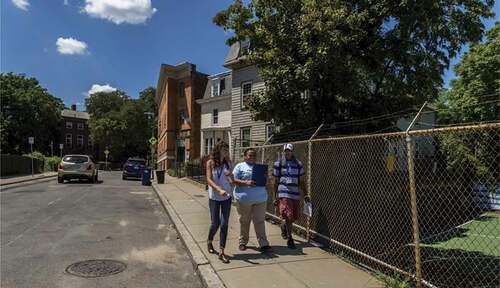
Gentrification exacerbates financial insecurity for economically vulnerable residents, leading to increased stress.
For the attention of: Urban policymakers, public health leaders, community organizations
The problem: Long-term residents of gentrifying neighbourhoods are increasingly concerned that new development and accompanying social and economic changes may be harmful to their community. Scholars are only beginning to understand the health impacts of gentrification, and have called for more research into the experience of living in a gentrifying neighbourhood to uncover potential pathways between gentrification and health such as stress.
What we did and why: In collaboration with a consortium of neighbourhood residents and organizations, we interviewed 40 financially vulnerable individuals living in gentrifying neighbourhoods to understand how the changes they experience in their communities shape different elements of their health and wellbeing. We used interviews because they are best for understanding subjective experiences like the feeling of being financially insecure.
What our study adds: Our results show that the experience of living in a gentrifying neighbourhood makes respondents more financially insecure. They perceive the changes in their neighbourhood as exposing them to increased financial risk while simultaneously reducing the efficacy of buffers they might have against that risk. This is stressful because the threats, harms and challenges associated with financial insecurity – such as the inability to afford housing – exceed respondents’ ability to cope. Financial stress is one way gentrification may harm health.
Implications for city policy and practice: Investments in buffers against financial insecurity in gentrifying neighbourhoods – such as rent control, preservation of affordable housing, increased access to affordable childcare, social and cultural cohesion, and the creation of well-paying jobs for community members – can be seen as health-promoting interventions. Residents and community organizations should play central roles in designing interventions to alleviate financial stress.
Further information about the full programme:
Conservation Law Foundation: Healthy Neighborhoods Study
Full research article: “It feels like money’s just flying out the window”: Financial security, stress and health in gentrifying neighborhood. Authors: Andrew Binet, Gabriela Zayas del Rio, Mariana Arcaya, Gail Roderigues & Vedette Gavin.
Illegal firework activity and environmental sound levels: Community impacts and solutions
‘NoiseScore’ smartphone app heat map data identifying firework hotspots based on (a) community-measured sound levels and (b) community subjective reports. Photo by Erica D. Walker.
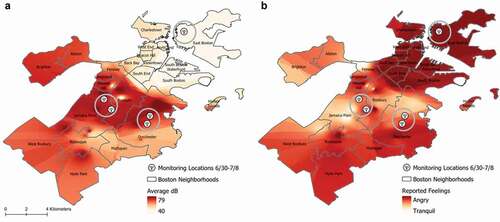
Learn how the City of Boston engages local researchers, community residents, and city officials to combat illegal firework activity.
For the attention of: City planners, city officials, residents, community and public health committees.
The problem: Concerned community residents, city officials, and academic researchers come together to measure and problem solve incessant illegal firework activity in the City of Boston.
What we did and why: Concerned residents reached out to a local research group (Community Noise Lab) and city officials to complain of the significant mental and physical health impacts of incessant firework activity during COVID-19’s stay-at-home advisory.
We used a research app called “NoiseScore” together with sound level meters, noise complaint calls, and census data to measure sound levels. These data allowed us to also be able to describe its impacts on community noise perception; map who is most vulnerable to such noise; and used these data to form the first ever Firework Task Force in the city of Boston.
Implications for city policy and practice: We explain the process of how a group of academic researchers, city officials, and concerned residents can come together to measure, report, and create a fireworks taskforce. This experience can be informative for cities and/or community residents who need to organize around an environmental issue and create a tangible, effective solutions.
For further information:
Community Noise Lab: Community Noise Lab is currently located at the Brown University School of Public Health. The lab’s primary aim is to holistically explore the relationship between community noise and health by working directly with communities to support their specific noise issues using real-time monitoring and exposure modelling. Our smartphone app, NoiseScore, which allows users to objectively measure and subjectively describe noise events in their community.
City of Boston – Fireworks Safety Guide: Sound levels from incessant use of fireworks are unreasonably loud. The City of Boston states that unreasonable sound levels are anything louder than 50 decibels from 11 pm to 7 am, or anything louder than 70 dB at anytime.
Full research article: Firework activity and environmental sound levels: community impacts and solutions by Erica D. Walker, Nina F. Lee, Koen F. Tieskens, Jonathan Jay, Lorrie J. Walker, Marisa Luse, Roudnie Celestin, Jerome Smith, Julia Mejia & Jonathan I. Levy.
Road traffic noise and mental wellbeing in the elderly
Night-time road traffic noise exposure at the most exposed facade or residential buildings, Dublin and Cork. Photo by Anne Nolan.
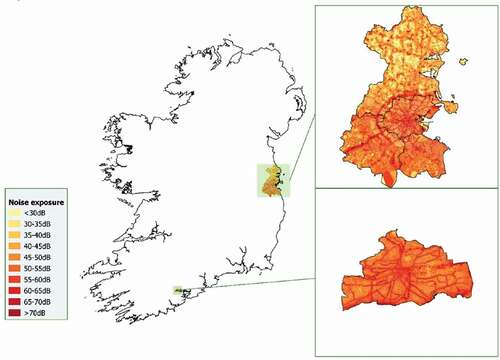
Want to know more about noise and mental wellbeing? Our latest research from two Irish cities.
For the attention of: Urban policy-makers and transport planners
The problem: Traffic noise pollution is an omnipresent feature of daily life, particularly in cities and urban areas. Unlike some other environmental stressors in cities such as second-hand smoke, dioxins and benzenes, human exposure to environmental noise from road traffic is increasing in Europe. There is relatively little scientific research investigating the links between road traffic noise and various aspects of mental wellbeing such as anxiety, worry, depression, and quality of life.
What we did and why: Our study estimated exposure to traffic noise for residences in two Irish cities, Dublin and Cork. This involved estimating noise exposure for each residential address and linking it to health, socio-demographic and behavioural information for 1,706 individuals aged 54 and over living in these two cities. The study tested whether aspects of mental wellbeing were lower among those exposed to higher traffic noise, thus examining the link between noise exposure and mental wellbeing.
What our study adds: We found a negative association between exposure to road traffic noise and quality of life that is independent of a range of socio-demographic and behavioural factors. In other word, an indication that people with lower road traffic noise exposure achieve higher quality of life scores, relative those people most exposed to noise. However, the study did not find evidence of an association between noise exposure and depression, anxiety, stress or worry.
Implications for city policy and practice: As environmental noise is an important feature of daily living in cities and urban areas, robust evidence on this issue is necessary in a global context of increasing urbanization
This research contributes to the evidence base informing noise-health policy decisions and mitigation measures for cities and urban areas. In particular, it implies that noise pollution from traffic should be high on the priority list for policymakers when designing policies for healthy cities of the future.
Full research article: Road traffic noise, quality of life, and mental distress among older adults: evidence from Ireland by Ciarán Mac Domhnaill, Owen Douglas, Seán Lyons, Enda Murphy & Anne Nolan.
Using local health information to improve alcohol licensing decisions
The classic depiction of a city without alcohol availability constraints: Hogarth Gin Lane 1751 engraving. © the Trustees of the British Museum. CC-BY-NC-ND.

Beyond the HALO effect! Including health in local alcohol license decisions is not just about a dedicated Health Associated Licensing Objective: A Public Health Perspective …
For the attention of: City licensing and alcohol officers and committee members
The problem: Local Public Health teams in England are now able to table objections to the granting of new licence applications for the sale of alcohol. For an objection to be valid however, it must be based on one or more licensing objectives which in England does not include health. This can effectively render any health-related evidence to be inadmissible and bring into question the legitimacy of public health input.
What we did and why: We examined the prospects for incorporating health related evidence into the alcohol license decision making process in a purposive sample of seven English local authorities. We wanted to establish if firstly it might be feasible to include health information under the existing licensing objectives or if there was a case that could be made for a separate new fifth objective around health and the advantages that might bring.
What our study adds: Constraints in using health information in alcohol licence decision-making are not restricted to the presence or absence of a dedicated Health as an Alcohol Licensing Objective (HALO) policy.
While such policy might enhance the legitimacy of public health input, improved access to localised health information, stronger collaborative working with other stakeholders and training in how to contextualise evidence for local council committees will all be critical to improving local alcohol harm reduction through licensing.
Implications for city policy and practice: The capacity to impose restraints on the availability of alcoholic beverages represents a key strategy in reducing alcohol harms and improving city well-being. We would stress that raising awareness of the wider health harms of alcohol in addition to its acute impacts such as crime and disorder, can improve the prospects for controlling availability. Though, the evidence needs to be contextualised and accessible for local licensing committees.
For further information:
Findings from the pilot of the analytical support package for alcohol licensing; Executive summary
Alcohol licensing in England and Wales: is it fit for purpose? AHA_Licensing_leaflet v5
Full research article: Assessing the feasibility of using place-based health information in alcohol licensing: case studies from seven local authorities in England by John D Mooney, Zeibeda Sattar, Frank deVocht & Jonathan Ling.
Housing instability and homelessness among older adults in Canada: experiencing precariousness while aging
George’s photo of rent-geared-to-income building during construction.
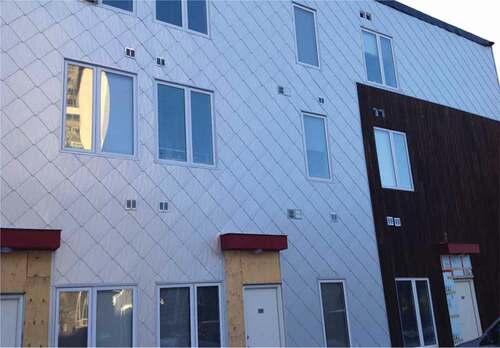
Housing instability and homelessness among older adults in Canada: experiencing precariousness while aging.
For the attention of: Municipal, provincial and federal aging and housing-related policymakers in Canada and globally.
The problem: In broad terms, aging trends in Canada are similar to those found in many countries. The number of adults over the age of 65 in Canada is estimated to grow to over 9.5 million by 2030, which will comprise of 23% of the total Canadian population. As a result, the housing instability experiences of low-income older adults and their effects on successful aging will be crucial in the coming decades. Rapid urban change in Hamilton, a mid-sized Canadian city (pop. 550,000) in the province of Ontario, has resulted in rapidly rising private sector rents and displacement among low-income older adults renting in the private sector. As such, many low-income older adult households are experiencing involuntary displacement through a number of landlord tactics, including raising rents, letting buildings fall into disrepair, and in some cases “incentivized” mobility, whereby cash bonuses are paid to tenants to move out, so the building can be renovated and leased for higher rents. Low-income older adults in Hamilton experiencing housing instability are at risk of becoming homeless for the first time as a senior.
What we did and why: We undertook a qualitative study of low-income older adults’ lived experiences of aging, precariousness and housing instability/homelessness instability/homelessness in Hamilton, Ontario. We are adding to the small, but growing body of literature on precarity, aging and housing. However, in a departure from this existing literature, the lived experiences of aging, precariousness and housing instability/homelessness gathered have been collected through a multi-modal approach. For this approach participants were given tablets to record their photos, videos and written diaries of their housing-related experiences. This was supplemented individual semi-structured interviews and participant observation in community-based settings. Data collection focused on capturing participant personal “touch points” in their own housing journeys.
This use of digital arts-based data gathering attempts to lessen the researcher-researched power imbalance by giving older adult participants the opportunity to exercise agency over which data are collected and when. This approach also assists in providing an appropriate platform for collecting sensitive and difficult to discuss housing instability/homelessness pathway experiences, which can be influenced by factors such as intimate partner violence and mental health and addiction challenges.
What our study adds: Participant narratives provide compelling counter stories contesting popular notions that older adults will be taken care of as they age by the state or private savings. Recounting of participant experiences through a sensemaking frame allowed for an exploration of the question of what it means to be “devalued” as one ages; to the extent that securing shelter is an overwhelming and stressful journey. In sharing these stories, we are attempting to bring “recognizability” to the experiences of aging, precariousness and housing/homelessness in order to contribute to the conditions through which low-income older adults’ experiences can be folded into policy co-design geared towards affordable housing.
Implications for city policy and practice: Our study provides lived experience data to support the development of policy frameworks focusing upon preventing housing instability and homelessness among older adults in Hamilton and other mid-sized cities in Ontario.
Specifically, the research:
Outlines participant pathways into housing instability and homelessness, and the strategies they employed to secure placement in social housing.
Shows how tracing these pathways can provide a participant-generated roadmap outlining areas for market-based, tenant protection and social service systems adjustment.
Indicates the need for specific municipal social service programming geared at housing to helping seniors navigate rental listings, identify suitable rentals, and then secure the rental housing.
Municipal programs should also aim to keep low-income older adults in their housing once they are housed, particularly when threatened with “renoviction” (a term used in Canada whereby a landlord evicts a tenant by claiming they will complete major renovations).
For further information: The Canadian Housing Evidence Collaborative: Our mission is to accelerate evidence-based solutions that advance Canada’s National Housing Strategy to ensure every Canadian has “housing that meets their needs and that they can afford”.
Full research article: A narrative-based exploration of aging, precariousness and housing instability among low-income older adults in Canada by C. Michelle Wyndham-West, Allison Odger & James R. Dunn.
Health in human settlements: Experiences of intersectoral collaboration in Douala, Cameroon
Aerial view of Douala.

Intersectoral collaboration is required to address urban health and housing challenges in African cities. Lessons from urban stakeholders in Douala, Cameroon.
For the attention of: City officials, Office of the Mayor, Resilience officers and urban municipalities (especially health, housing and urban planning departments.
The problem: The poor housing conditions in urban informal settlements are detrimental to population health and wellbeing. As such, addressing these conditions, and associated adverse health outcomes, requires collaborative action from city stakeholders in the health, housing, and urban planning sectors. To date, there has been limited academic evidence of the presence and implementation of intersectoral collaborations in the African context.
What we did and why: We interviewed experienced stakeholders working in Douala’s health and human settlements to explore their perspectives and experiences on the key health and housing issues faced in the rapidly growing city of Douala, Cameroon; and the potential of intersectoral collaboration to address these challenges.
What our study adds: Our study identified the need to broaden city stakeholders understanding of the relationship between inadequate housing and health beyond water-and vector-borne diseases. It also provides important insights on the reactive nature of intersectoral collaboration in a sub-Saharan African city, with collaboration limited to the contexts of specific events, disaster response, and health awareness initiatives. The study also explores the organisational barriers to and facilitators of intersectoral collaboration.
Implications for city policy and practice: Our study supports a re-imagination of urban governance structures is needed to support intersectoral collaboration. A vital lesson we found is that there is a need for more transdisciplinary research partnerships working with policymakers to contribute to the design of intersectoral action for health in ways that integrate existing evidence and incorporate health impact evaluation.
For further information:
RICHE – Africa Workshop On Healthy Cities: Intersectoral Approaches To Non-Communicable Disease Prevention In Africa
Full research article: Intersectoral collaboration for healthier human settlements: perceptions and experiences from stakeholders in Douala, Cameroon by Blaise Nguendo-Yongsi, Trish Muzenda, Yves Bertrand Djouda Feudjio, Daline Nora Kenfack Momo & Tolu Oni.
